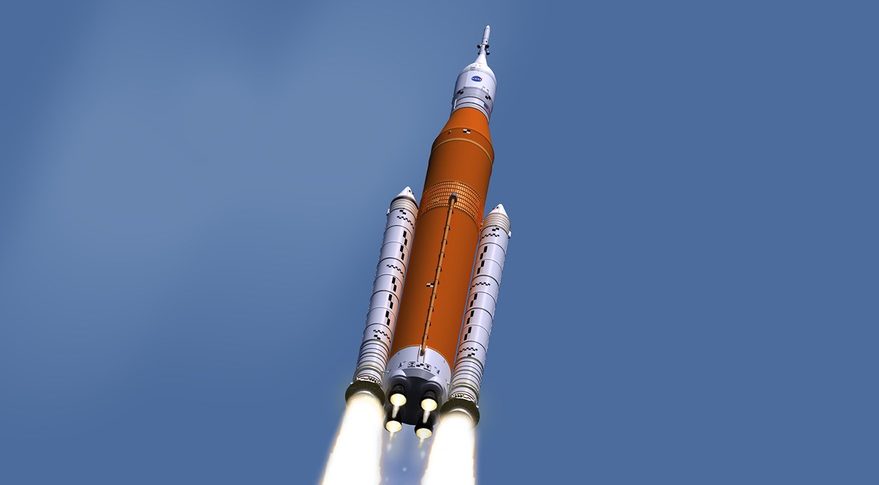NASA Inspector General Warns Limited Budget Reserves Could Delay Key Programs

WASHINGTON — As NASA prepares to update the schedule for the first flight of its Space Launch System, a report by the agency's inspector general warns a lack of budget reserves could lead to more delays in the future.
The Nov. 6 report by the NASA Office of Inspector General (OIG), addressing what it considers to be the agency's top management and performance challenges, also identified potential cost and schedule issues with a pair of science missions scheduled for launch in 2018.
In the report, OIG noted that SLS had budget margins far below what is usually mandated for programs under development. Citing procedures established at the Marshall Space Flight Center, the lead center for SLS, "the standard monetary reserve for a program such as the SLS should be between 10 and 30 percent during development," the report stated.
"The SLS Program did not carry any program reserves in fiscal year (FY) 2015 and only $25 million in FY 2016 — approximately 1 percent of its development budget," the report stated. "Moving forward, the SLS Program plans to carry only minimal reserves through 2030, which in our view is unlikely to be sufficient to enable NASA to address issues that may arise during development and testing."
The Orion crew vehicle program also has budget reserves of less than one percent, the report noted. NASA, though, plans to increase the reserves "to a more appropriate level" starting in 2019 or 2020 in advance of the first crewed Orion flight in the early 2020s.
How those limited budget reserves will affect the schedule for future missions remains to be seen. NASA has yet to announce a new launch date for the first SLS mission, named Exploration Mission (EM) 1, but notified Congress this summer that the launch would take place no earlier than October 2019, 11 months later than previously scheduled.
Agency officials said last month at the American Astronautical Society's Wernher von Braun Symposium in Huntsville, Alabama, that they expected a revised EM-1 launch date to be finalized within the next month. Bill Gerstenmaier, NASA associate administrator for human exploration and operations,testified about the status of NASA's exploration programs at a House space subcommittee hearing Nov. 9
Breaking space news, the latest updates on rocket launches, skywatching events and more!
The OIG report identified issues with the October 2019 launch date, such as welding problems with the core stage of the SLS. "Notwithstanding the 1-year launch delay, testing and delivery of the core stage remains on the critical path with little schedule margin available to manage problems that may arise during the integration and test phase before an integrated SLS/Orion launch," the report stated.
Schedule concerns extend to EM-2, the first crewed mission, which will also be the first flight of the SLS with a more powerful upper stage called the Exploration Upper Stage (EUS). That will require changes to both the SLS itself as well as ground systems at the Kennedy Space Center. The OIG warned in its report that the Ground Systems Development and Operations program, responsible for the SLS/Orion ground systems, "has identified a budget shortfall associated with EUS upgrades that will need to be addressed."
The report separately raised questions about the status of some NASA science missions. Among them is Parker Solar Probe, a mission to travel closer to the sun than any previous spacecraft. The spacecraft is in the final stages of assembly and testing for a launch in mid-2018 during a 20-day window.
According to the OIG report, issues with both instruments and spacecraft subsystems had consumed some schedule reserve, as well as budget reserves held by NASA Headquarters. "As the Project begins spacecraft-level environmental testing, solving any remaining technical issues in time to meet the launch window is imperative if NASA is to avoid a minimum 10-month launch delay," the report concluded.
NASA Acting Administrator Robert Lightfoot, in a response included in the report, remained optimistic that Parker Solar Probe would launch on schedule. "The Project currently holds adequate schedule and cost reserves to achieve an August 2018 launch," he said.
OIG also warned of potential cost increases in Ice, Cloud, and land Elevation Satellite-2 (ICESat-2), which has already suffered problems during its development. Difficulties with its single instrument, a laser altimeter, delayed its launch by more than a year from May 2017 to September 2018, and increased its cost by nearly 25 percent to $1.06 billion.
In the report, OIG said that a failure of one of the two lasers built for that instrument during tests last year caused a three-month schedule slip from June to September 2018, "and costs may increase to support the additional work."
This story was provided by SpaceNews, dedicated to covering all aspects of the space industry.

Jeff Foust is a Senior Staff Writer at SpaceNews, a space industry news magazine and website, where he writes about space policy, commercial spaceflight and other aerospace industry topics. Jeff has a Ph.D. in planetary sciences from the Massachusetts Institute of Technology and earned a bachelor's degree in geophysics and planetary science from the California Institute of Technology. You can see Jeff's latest projects by following him on Twitter.

